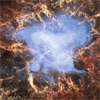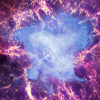CXC Home | Search | Help | Image Use Policy | Latest Images | Privacy | Accessibility | Glossary | Q&A
Tour of Crab Nebula
Quicktime MPEG
The Crab Nebula is one of the most studied objects in the night sky. First observed by Chinese astronomers in 1054 A.D., and possibly others, this supernova remnant and its neutron star have become favorite targets for amateur and professional astronomers alike. This version of the Crab Nebula combines data from three different telescopes. X-ray data from Chandra, in light blue, show the super-dense neutron star that is the core of the exploded star, which is shooting a blizzard of high-energy particles into the expanding debris field. This super-energetic outflow is striking the cooler gas and dust seen in optical data from Hubble as well as infrared light from Spitzer. The Crab Nebula contains incredibly intriguing science, and provides perhaps one of the most stunning images in all of astronomy.
[Runtime: 00:51]
Quicktime MPEG
The Crab Nebula is one of the most studied objects in the night sky. First observed by Chinese astronomers in 1054 A.D., and possibly others, this supernova remnant and its neutron star have become favorite targets for amateur and professional astronomers alike. This version of the Crab Nebula combines data from three different telescopes. X-ray data from Chandra, in light blue, show the super-dense neutron star that is the core of the exploded star, which is shooting a blizzard of high-energy particles into the expanding debris field. This super-energetic outflow is striking the cooler gas and dust seen in optical data from Hubble as well as infrared light from Spitzer. The Crab Nebula contains incredibly intriguing science, and provides perhaps one of the most stunning images in all of astronomy.
[Runtime: 00:51]
(Credit: X-ray: NASA/CXC/SAO/F.Seward; Optical: NASA/ESA/ASU/J.Hester & A.Loll; Infrared: NASA/JPL-Caltech/Univ. Minn./R.Gehrz)
Great Observatories Composite Image of Crab Nebula
Quicktime MPEG
This composite image uses data from three of NASA's Great Observatories. The Chandra X-ray image is shown in blue, the Hubble Space Telescope optical image is in yellow and red, and the Spitzer Space Telescope's infrared image is in purple. The X-ray image is smaller than the others because extremely energetic electrons emitting X-rays radiate away their energy more quickly than the lower-energy electrons emitting optical and infrared light. The Crab Nebula is one of the most studied objects in the sky, truly making it a cosmic icon.
[Runtime: 00:14]
Quicktime MPEG
This composite image uses data from three of NASA's Great Observatories. The Chandra X-ray image is shown in blue, the Hubble Space Telescope optical image is in yellow and red, and the Spitzer Space Telescope's infrared image is in purple. The X-ray image is smaller than the others because extremely energetic electrons emitting X-rays radiate away their energy more quickly than the lower-energy electrons emitting optical and infrared light. The Crab Nebula is one of the most studied objects in the sky, truly making it a cosmic icon.
[Runtime: 00:14]
(Credit: X-ray: NASA/CXC/SAO/F.Seward; Optical: NASA/ESA/ASU/J.Hester & A.Loll; Infrared: NASA/JPL-Caltech/Univ. Minn./R.Gehrz)
Return to Crab Nebula (November 23, 2009)




